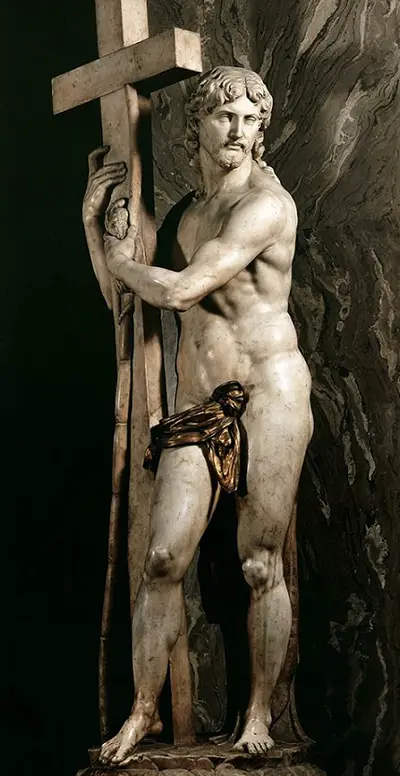Today the sculpture resides in the Santa Maria Sopra Minerva, in Rome. It is located to the side of the main altar within the church.
It was Metello Vari who originally commissioned the work for Michelangelo in 1514. His only stipulation was that Christ should hold the cross within his arms. Other than this one request, the rest of he sculpture and artistic design was left up to Michelangelo.
His first attempt, during 1515, while he was working in his workshop, was sadly later abandoned due to a black line running throughout the marble. At the time Michelangelo was most upset about having to delay his work and worried about completing on the date that he had given.
There was a great delay in the constructing of the sculpture, due to the fact that he had to order in especially, a new slab of marble, and this took some time as it had to be shipped in. He therefore created a new version of the Risen Christ (Cristo della Minerva), during 1519 to 1520, so as to honour the contract with Metello Vari.
He worked upon this masterpiece while living in Florence, and then after he relocated to Rome. This version of the Risen Christ was then given to Metello Vari, during 1522, which he kept in his home garden that was close to the Santa Maria sopra Minerva. It resided there until 1556.
Not much is known about the whereabouts of the initial first version of the sculpture, other than it was reportedly up for auction during 1607 and then nothing else was documented about this great work until 2000.
It was during this year that Irene Baldriga found the original Risen Christ, that had been reworked during the 1600s, in the San Vincenzo Martire church located in Viterbo. It was understood to be the original working version due to the black line running throughout the marble, that was clearly visible on the face of Christ.
The Risen Christ (Cristo della Minerva) impressed both Michelangelo's contemporary and art critics. Both Sebastiano del Piombo and William Wallace, praised the sculpture. What we observe is Christ, who is naked, standing in a relaxed pose.
Although naked, the image is not sexually promiscuous but rather the opposite, as we see Christ in all of his vulnerability, devoid of lust and sin. Over time many adaptations have been made to the original sculpture.
These include holes being added to the palms of Christ to denote the Crucifixion and the addition of a gold loin cloth to protect Christ's modesty. Therefore what we observe today is an entirely different image from the one that Michelangelo originally conceptualised from his slab of marble.
While Michelangelo created this masterpiece of sculpture, he had no working title, nor final title for his work. The sculpture was given the name of the Risen Christ, because that is what we see. The image of Christ at the Resurrection, as he stands with the holy cross. The image has been copied many times in other works of art, that have been given similar titles.
The Risen Christ by Michelangelo is laden with symbolism. His original work, without adaptations, has no crucifix markings and Christ was unharmed, depicting that he was whole and unharmed after his resurrection.
Symbolism that was sadly lost with the later changes that were made by other individuals. There is so much skill and attention to detail in this great sculpture. Firstly, we have the portrayal of the nude figure of Christ, which is perfectly in proportion and anatomically correct. The chest is incredibly detailed, and the muscles well sculpted and defined. It is this fine attention to detail, and perfect reconstruction of the male form through sculpture, that sets Michelangelo apart from other artists within the era.


